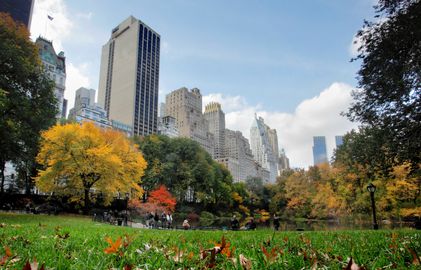

An oasis in the middle of city chaos and pollution, Central Park is the most visited urban park in the United States. Between thirty-five and forty million annual visitors come to the park to take stroll, rent a rowboat or a horse carriage, play baseball, ride a bike, jog, shoot a film, ice skate, admire the changing colors of the foliage, have a picnic or just get away from the noise and stress of Manhattan.
Central Park was first opened to the public in the middle of 19th century. It consisted of 778 acres of land owned by the city. A year later the authorities decided to expand and improve the park and held a design competition, which was won by landscape architects Frederick Law Olmsted and Calvert Vaux. Their project, titled the Greensward Plan, enlarged the park's overall territory to 843 acres, which is equal to about three and a half square kilometers. The project also removed certain animals, such as the sheep that grazed the area known today as Sheep Meadow, and relocated them to other boroughs of the city. The park, which in the last one hundred years has undergone many extensive renovation and restoration projects, is owned today by the New York City Department of Parks and Recreation and is operated by the Central Park Conservancy, which has an annual budget of about 60 million dollars.
Central Park has a rectangular shape and is framed by Central Park South, which is part of 59th Street, Central Park North, which is part of 110th Street, Central Park West, which is part of Eight Avenue and Fifth Avenue in the east, the only street that has maintained its original name. It is also outlined by some of the most exclusive residential buildings in the city, reminding the park's visitor that, even though he is immersing himself in nature, ultimately he is still surrounded by a city.
The park contains six artificial lakes and ponds, a wildlife sanctuary, natural woods with a vast variety of flora and fauna, ten-kilometer-long walking tracks and bicycle lanes that are connected by 36 bridges, two ice-skating rinks, one of which becomes in a swimming pool in the summer, a zoo, a conservatory garden, numerous indoor children's playgrounds, a 106-acre billion-gallon reservoir, a couple of very prestigious restaurants and the outdoor Delacorte Theater, which hosts the Shakespeare in the Park theatrical festivals. There are also seven big lawns, the largest of which is called the Great Lawn, in the center of the park, as well as many other smaller grassy areas that are used for team sports or just areas for relaxation. The park is closed to car traffic after 7pm and on weekends.
The park's most important sculptures and structures are the Cleopatra's needle, a 2,500-year-old obelisk brought from Egypt; the King Jagiello Monument, dedicated to the 15th-century Polish ruler; the Christopher Columbus, William Shakespeare, Hans Christian Anderson and Alice in Wonderland statues, the Balto statue dedicated to the Siberian Husky sled dog that in the beginning of the 20th century transported crucial medicine in Alaska to combat a deadly disease, as well as two monuments that stand by the park entrances on Central Park South - the Simon Bolivar Monument, dedicated to the liberator of South America from Spanish rule, and the gilded Sherman Monument, honoring American Civil War general William Sherman.
Indoor places of interest include the Belvedere Castle overlooking the Great Lawn, the Swedish Cottage Marionette Theatre and the Carousel, one of the largest merry-go-rounds in America. Central Park enthusiasts will argue that even the Metropolitan Museum of Art stands in the park and not on Fifth Avenue. Sports lovers will find plenty of space to play baseball, tennis, volleyball, croquet and lawn bowling. There are also enormous boulders that will make rock climbers very happy. The most popular sportive event, though, is the internationally renowned New York Marathon, whose finish line awaits participants right by the park's most exquisite eating establishment, Tavern on the Green. Another enjoyable restaurant is the Loeb Boathouse overlooking The Lake. Next to it is a dock where you can rent a rowboat and enjoy an outing on the placid waters.
Central Park has been used as a setting in numerous films, the most famous of which is doubtlessly the Marathon Man with Dustin Hoffman. While J. D. Salinger's novel the Catcher in the Rye is the most celebrated literary work that is associated with the park. Writers, artists and musicians continue drawing inspiration from the park today, as it always offers a fresh perspective on New York and on the people who inhabit and visit it.